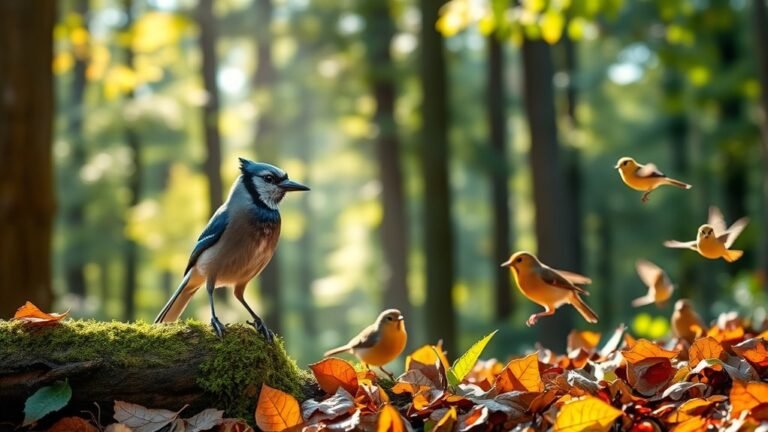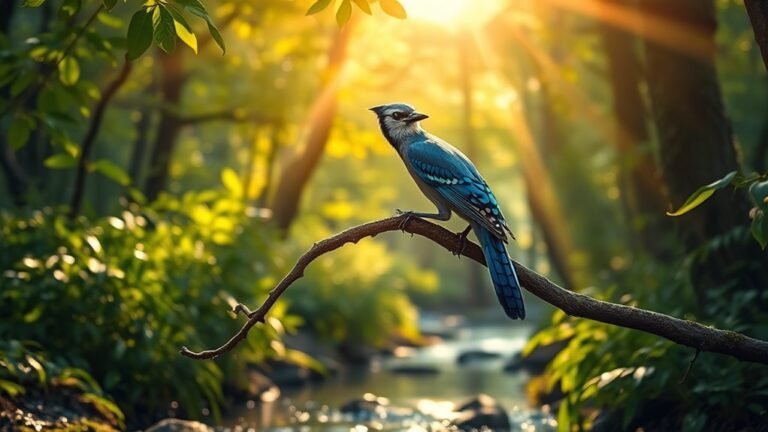The Common Cuckoo: Nature’s Most Notorious Parent
The common cuckoo uses a unique reproductive strategy called brood parasitism. It lays its eggs in the nests of other birds, avoiding the need to raise its young. This behavior leads to questions about survival and morality in nature. What motivates the cuckoo to act this way? How do the host birds react to this trickery? By exploring these questions, we learn more about the delicate balance in ecosystems.
The cuckoo's method is not just clever; it also showcases the adaptability of species in the wild. Host birds often develop their own strategies to identify the cuckoo's eggs. This competition illustrates the constant struggle for survival among different bird species.
Understanding the common cuckoo's behavior helps us appreciate the complexities of nature while highlighting the creativity of life in the wild.
Key Takeaways
- The Common Cuckoo practices brood parasitism by laying its eggs in the nests of other bird species.
- Cuckoo eggs closely resemble host eggs, ensuring they are cared for by unsuspecting foster parents.
- Cuckoo chicks grow rapidly, often pushing out host eggs or chicks to monopolize resources.
- Host species develop countermeasures, such as rejecting cuckoo eggs or leading aggressive defenses.
- The ethical implications of cuckoo parasitism raise questions about care dynamics and instinctive behaviors in nature.
The Unique Behavior of Brood Parasitism
Many birds care for their young, but the common cuckoo behaves differently through brood parasitism. This means a female cuckoo lays her eggs in the nests of other bird species. By doing this, she avoids raising her own chicks. The cuckoo egg often looks like the host's eggs. This mimicry helps ensure that the host raises the cuckoo chick, often without realizing it. This strategy allows the cuckoo to focus on laying more eggs rather than caring for the young.
Cuckoo behavior shows how animals adapt to survive. It also highlights the ongoing struggle between cuckoos and the birds they use. This relationship is an example of how nature balances cooperation and competition.
Understanding these interactions can be both interesting and informative, revealing the unique strategies animals use in their lives.
The Life Cycle of the Common Cuckoo
The life cycle of the common cuckoo is efficient and intriguing. A female cuckoo looks for a host nest, usually belonging to birds like warblers or dunnocks. While the host bird is distracted, she lays one egg in the nest. This strategy is important because the cuckoo chick hatches first and grows quickly. It often pushes out the host's eggs or chicks to gain more attention.
The average life span of a cuckoo is about 4 to 5 years. Afterward, the female migrates to start the process again, ensuring her genes are passed on.
Observing these behaviors shows how the cuckoo adapts well to its environment. It exploits the care provided by other birds, showcasing a unique survival strategy in nature.
Host Species and Their Struggles
Cuckoos take advantage of the nests of other bird species. This behavior creates serious problems for host birds. When cuckoos lay their eggs in a host's nest, the host birds often end up raising young that aren't theirs. This situation negatively affects the survival of their own chicks.
- Host species may leave their own eggs behind.
- Cuckoo chicks can push out the host's biological young.
- False parenthood causes stress and disrupts normal behaviors.
- Continuous cuckoo parasitism can lead to declines in bird populations.
These challenges highlight the delicate balance in nature. They show how one species' actions can significantly impact another's ability to reproduce and thrive.
Adaptations and Countermeasures
Cuckoo parasitism challenges host bird species. Many birds have developed adaptations to counter these threats.
Some host birds recognize and reject cuckoo eggs by comparing them to their own brightly colored eggs. Other birds nest in hidden spots to avoid detection by cuckoos.
Some host species display aggressive behaviors, attacking or chasing off cuckoo intruders. These behaviors illustrate how nature adapts.
Each evolutionary change helps maintain ecological balance. This ongoing interaction between cuckoos and their hosts highlights a fascinating relationship in the bird world.
The Ethical Implications of Parenting in Nature
Cuckoo parasitism raises important questions about parenting in nature.
While many animals act on instinct to survive, cuckoos deceive other birds to raise their young. This behavior forces us to think about the ethics of such strategies.
- Is it acceptable to trick others for personal benefit?
- How do we evaluate the care given to unrelated chicks?
- What're the emotional effects on the birds that unwittingly raise cuckoo chicks?
- Can we separate instinct from ethical behavior in animals?
These questions encourage us to examine the realities of parenting within the animal kingdom.
The Broader Impact on Ecosystems
Cuckoo parasitism affects ecosystems by changing how birds interact and maintain stable populations. When a cuckoo lays its eggs in another bird's nest, it disrupts the host bird's reproduction.
This disruption can lead to fewer host birds, impacting food sources and predator-prey connections. The presence of cuckoos forces host birds to adapt, which can lead to evolutionary changes.
These adaptations may help bring back some balance, but they can also stress populations that are already vulnerable. Overall, these impacts show how interconnected and fragile ecosystems are, highlighting the importance of protecting these relationships.
Frequently Asked Questions
What Do Common Cuckoos Eat Throughout Their Lives?
Common cuckoos eat various insects, primarily caterpillars and beetles. Their diet changes with the seasons as they adapt to find the best food sources. This flexibility helps them thrive in different environments and conditions.
How Far Do Common Cuckoos Migrate Each Year?
Common cuckoos migrate every year. They travel up to 12,000 kilometers. Their migration routes cover Europe and Africa. This journey is important for their survival during seasonal changes and the availability of food.
Can Common Cuckoos Recognize Their Own Chicks?
Cuckoos practice brood parasitism. They lay their eggs in other birds' nests instead of raising their own chicks. This behavior makes it hard for cuckoos to recognize their own chicks. They cannot identify their young among the chicks of the host birds.
What Are Common Predators of the Common Cuckoo?
Common cuckoos have several predators that pose threats to their survival. Hawks are among their main predators, using their speed and agility to catch unsuspecting cuckoos. Additionally, competition for nests from other birds can make it hard for cuckoos to thrive. Understanding these challenges is vital to grasp how cuckoos live and survive in their environment.
How Do Researchers Study Common Cuckoo Behavior?
To study common cuckoo behavior, observe their actions and analyze their nest parasitism. This approach gives you insights into their breeding habits and helps you understand their role in the ecosystem and their adaptations over time. By watching how they interact with other birds, you can learn about their strategies for survival and reproduction. Engaging with this research can deepen your appreciation for these unique birds and their impact on nature.

Hello, I’m Emily Price, the founder of Birds Affection. As a passionate bird enthusiast and spiritual seeker, I’ve always been fascinated by the symbolic meanings and mystical connections between birds and our lives. On this website, I share my knowledge and insights on the spiritual significance of various bird species, exploring their roles as messengers, guides, and teachers. Through my writing, I aim to inspire and educate others on the profound wisdom and beauty that birds bring to our world. Join me on this journey as we delve into the enchanting realm of bird symbolism and discover the hidden meanings behind these magnificent creatures.






